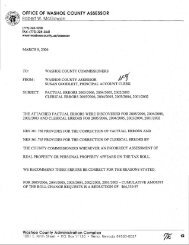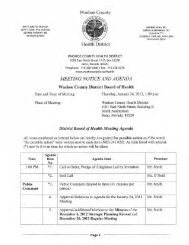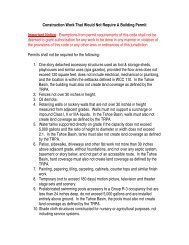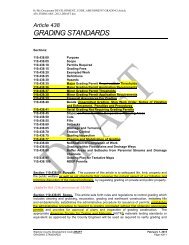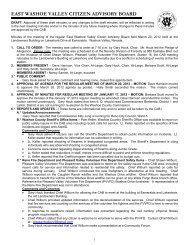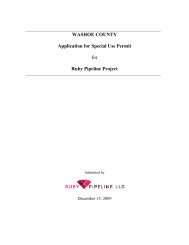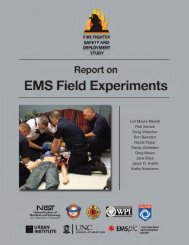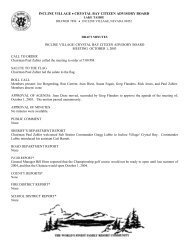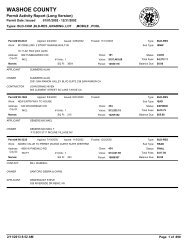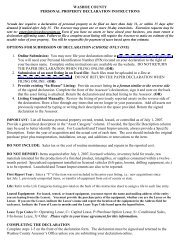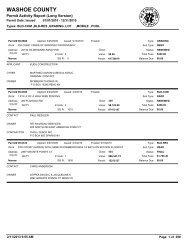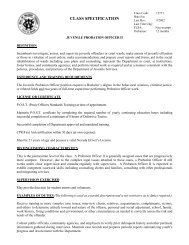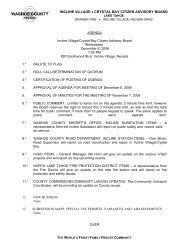South Truckee Meadows General Improvement District
South Truckee Meadows General Improvement District
South Truckee Meadows General Improvement District
Create successful ePaper yourself
Turn your PDF publications into a flip-book with our unique Google optimized e-Paper software.
Minutes of the Washoe County Well Mitigation Hearing Board, March 16, 2006 Page 4 of 12<br />
adjacent well was 148 feet below land surface; therefore, from 1959 to 1989 the water table dropped<br />
approximately 50 feet, or approximately L66 feet per year.<br />
Mr. Smitherman stated that the water table in the subject area has fluctuated over time and was declining<br />
during the thirty years prior to construction of STMGID well numbers 5 and 6 and Tessa wells I and 2.<br />
He added that most of the welis in the Government Lots were drilled between 1985 and 1995, many of<br />
which were drilled in bedrock. The average static water level for wells drilled in bedrock in the southern<br />
portion of the Govemment Lots in the early 1990s was approximately 240 to 250 feet below land surface,<br />
which is consistent with the information on the applicant's well.<br />
Mr. Smitherman reported the Tessa wells began service in 2003. He added that the hydrograph for Tessa<br />
I shows no decline and the hydrograph for Tessa 2 shows a fluctuation in the pumping level.<br />
Hydrographs for STMGID wells 5 and 6 between 2002 and 2005 show pumping level fluctuations in the<br />
water table, with a decline of approximately 19 feet in number 5 and 7.5 feet in number 6. He reported<br />
that STMGID 6 is the closest production well to the subject well, which is approximately 3,100 feet to the<br />
northeast. Tessa 2 and ArrowCreek 3 wells are also within one mile of the subject parcel.<br />
Mr. Smitherman reported that the applicants claim their well failed in August 2005. The applicants also<br />
stated that at that time, their pump was lowered to the bottom of the well but they were still unable to<br />
pump water. Mr. Smitherrnan continued that in August 2005, the static water level in the well was 284<br />
feet below land surface and the total depth of the well was297 feet for a saturated thiclness in the well of<br />
13 feet.<br />
Mr. Smitherman next reviewed the general information for the subject area. There are approximately 530<br />
domestic wells in the Government Lots, of which approximately 45 have been converted to municipal<br />
water in the last three years. The average metered home in the area uses approximately .84 acre-feet per<br />
year. Septic system recharge for the area is estimated at .22 acre-feet per year. The State Engineer's<br />
office estimates a total water use for domestic well owners at I.l2 acre-feet per year. The total amount of<br />
water withdrawn by 490 domestic wells using that estimate is 548.8 acre-feet per year. The same number<br />
of homes estimated by using a .62 acre-feet estimate equals about 303-304 acre-feet per year.<br />
Mr. Smitherman reported that monitoring wells in the Government Lots that appear to have the highest<br />
rate of decline are located closer to STMGID 6. The Melarkey well, which is located close to STMGID 6<br />
has been measured since 1989 and shows an average decline in the water table from 1989 to 2002 of L67<br />
feet per year. He reported that two of the wells that show a decline in the water table of less than one foot<br />
per year (similar to the Shannon's well) showed an increase in the water level during the years with above<br />
average precipitation.<br />
Mr. Morros asked about two homes being served by a single well. He added that State water law requires<br />
a permit if more than one single-family dwelling is to be served by one well. Ms. Shannon reported she<br />
would address that issue in her comments.<br />
Chairman Jacobson stated that in general he prefers to see for example 0.84 as opposed to .84 because it<br />
is sometimes difficult to read the copies. He also recommended rounding the number of feet rather than<br />
using decimals. He referred to the comment that the applicant was required to not use more than 1,800<br />
gallons per day although the meter had not been read. Mr. Smitherman explained that there was not a<br />
requirement that the meter had to be read. He clarified the permit was issued by the Washoe County<br />
<strong>District</strong> Health Department.<br />
Mike Widmer, Hydrogeologist with Washoe County Deparknent of Water Resources (DWR), stated he is<br />
representing the water purveyor, STMGID. He noted that Birnie McGavin, a member of the STMGID<br />
Local Managing Board was present if anyone had questions. Mr. Widmer stated in his opinion the<br />
Item 3<br />
Page 8



